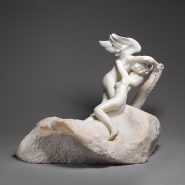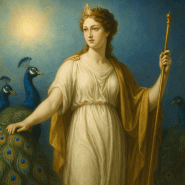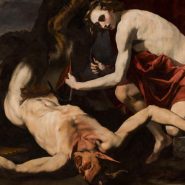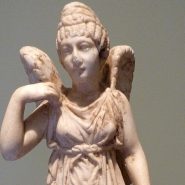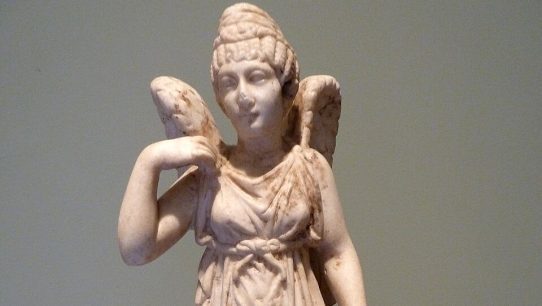Pietas, one of the most revered personifications in Roman culture, embodied duty — the sacred obligation to one’s gods, family, and country.
To the Romans, pietas was not merely a virtue but the foundation of civilization itself. It bound the individual to the divine and the community through respect, loyalty, and sacrifice.
In art and literature, Pietas was both a goddess and an ideal, representing the highest expression of Roman moral order.
Origins and Meaning
The word pietas in Latin carries a depth of meaning that transcends its English equivalent, “piety.” It signified devotion, righteousness, and a profound sense of responsibility toward the divine hierarchy and human kinship. Romans viewed pietas as a measure of moral worth — the guiding principle that sustained the Republic and later the Empire.
As a divine figure, Pietas personified this abstract virtue. She was not a goddess of worship in the traditional sense but a moral compass elevated to divine status. Her image stood for the very character Rome sought to cultivate in its citizens: obedience to the gods, fidelity to family, and service to the state.
Pietas in Myth and Literature
Pietas found her most enduring expression in the epic of Aeneas, the Trojan hero and legendary founder of Rome. In Virgil’s Aeneid, Aeneas is repeatedly called pius Aeneas — “dutiful Aeneas.” His life exemplifies the principle of pietas: he honors his father Anchises, protects his son Ascanius, and obeys the will of the gods even at great personal cost.
When he carries his aged father on his shoulders out of burning Troy, Aeneas becomes the living embodiment of the virtue. His sacrifice and discipline contrast sharply with the self-serving passions that doomed Troy. Through him, Rome’s destiny is portrayed as divinely sanctioned — built not on strength alone, but on moral integrity.
This literary ideal made pietas the cornerstone of Roman identity. It represented balance: emotion tempered by reason, ambition guided by duty, and power restrained by reverence for higher order.
Symbolism and Depictions
In Roman art, Pietas was portrayed as a serene woman, often veiled and modestly dressed, offering incense at an altar or clasping her hands in devotion. Sometimes she was depicted holding a child or an animal to be sacrificed — gestures symbolizing selflessness and care.
The imagery reinforced the concept that devotion required action. Pietas was not passive reverence but active duty — a continual offering of one’s labor, love, and loyalty to those who deserved honor.
Her symbols included the altar, representing worship; the veil, signifying modesty and humility; and the child, evoking familial duty. Coins from the reigns of Augustus and Hadrian frequently depicted her, underscoring the emperor’s role as guardian of Roman virtue.
Worship and Temples
Pietas was honored as a divine virtue during both the Republic and the Empire. A temple dedicated to her was built in 191 BCE by Manius Acilius Glabrio, near the Forum Holitorium, after his victories in battle — a gesture affirming that triumph required divine and moral sanction.
The temple served not just as a place of worship but as a civic statement. It reminded the Roman people that military success was meaningful only when accompanied by ethical conduct and fidelity to the gods.
Offerings to Pietas were made by citizens seeking moral strength, especially before major decisions or during times of crisis. She was invoked by soldiers, parents, and magistrates alike — all seeking to uphold their obligations with dignity and honor.
Pietas and Roman Society
Among the virtutes Romanae, or Roman virtues, pietas was considered one of the highest. It unified other key values — fides (faith), constantia (steadfastness), and gravitas (seriousness) — into a single moral ideal.
A Roman without pietas was thought to lack the very essence of humanity. It defined the proper relationship between mortals and the divine, and between citizens and the state. In this sense, Pietas was both a personal virtue and a political principle: loyalty to family mirrored loyalty to Rome itself.
Roman emperors frequently associated themselves with Pietas to project moral legitimacy. Statues, inscriptions, and coins featuring the goddess reinforced the idea that imperial authority rested on moral responsibility, not tyranny.
Legacy and Influence
Even after the decline of Roman religion, the concept of pietas endured as a cornerstone of Western moral thought. In early Christian writings, pietas evolved to mean devotion to God and compassion toward others — blending Roman duty with spiritual humility.
The image of Pietas influenced later representations of the Virgin Mary, whose compassion and obedience echoed similar ideals of maternal devotion and sacrifice. The Renaissance, in turn, revived her as an allegory of virtue and civic responsibility.
In modern terms, Pietas remains a reminder that duty — whether to family, community, or principle — is the measure of true strength. She represents the harmony between faith and action, a value as relevant today as it was in the days of Rome.
